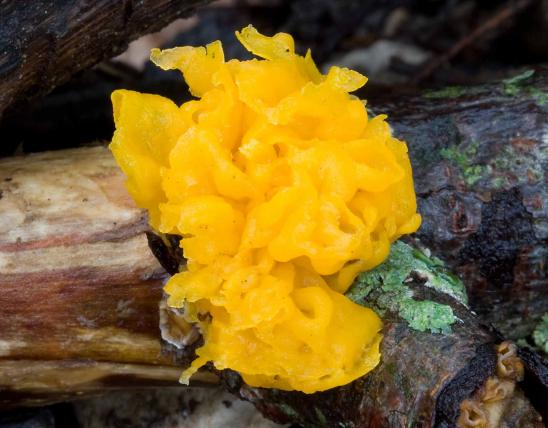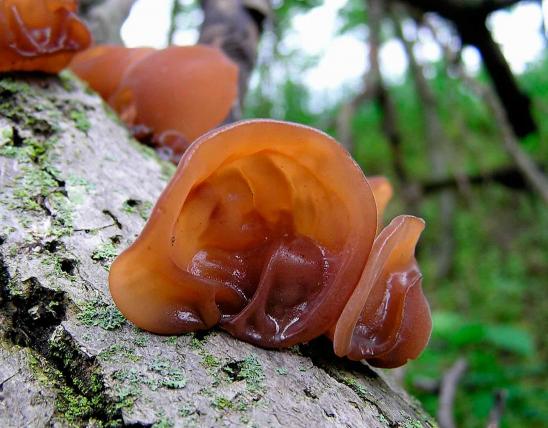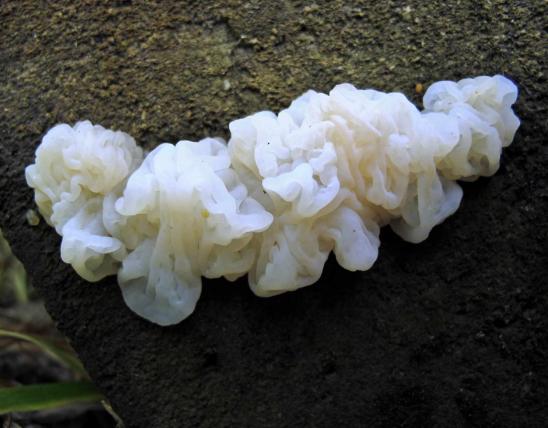
Cedar-apple rust is a fungus whose life cycle involves two host plants: some type of juniper (in our state, usually eastern red cedar) plus trees and shrubs in the rose family, especially apple and crabapple. The two life stages of this fungus look quite different.
On cedars, this rust forms brown or purplish, rather woody, dimpled long-lasting galls on twigs. Some people think they look like lumpy brown golf balls. Upon maturity, and after a spell of wet springtime weather, orange or golden gelatinous, tentacle-shaped structures (telial horns) emerge from pimple-like depressions of the gall. These produce spores (teliospores). The horns swell in wet weather to look like inflated sea anemone tentacles. When they dry, they shrivel and shrink to look like rusty, crusty spines or horns.
On apples and crabapples, this fungus is less spectacular. It first appears in spring as yellow spots or lesions on the upper sides of leaves; the spots grow larger and darker over time, becoming orange or reddish. Later, tiny black dots appear on these spots. Finally, late in the growing season, the leaf undersurface beneath each spot grows outward into a flattened, wartlike structure, and a crown of small, threadlike or tubular horns extends downward in a ring around the flattened wart. These horns can occur on the surface of apples or on twigs, too.
Similar species: Cedar-hawthorn rust and cedar-quince rust are very closely related to cedar-apple rust. All three can involve more types of host plants than their names suggest, including many other junipers as well as several woody members of the rose family.
- Cedar-hawthorn rust (G. globosum) looks quite similar to cedar-apple rust. The galls of cedar-hawthorn rust, however, are smaller, and the gelatinous horns are shorter, usually forming a three-dimensional star shape instead of looking like noodles or tentacles. Cedar-hawthorn rust mainly infects hawthorns, apples, crabapples, pears, quince, and serviceberry.
- Cedar-quince rust (G. clavipes), instead of forming rounded, woody galls on the cedar host, causes flaky swellings on the branches, which can kill small branches or young cedar trees by girdling (interrupting the vascular tissues). Rain causes the orange, crusty-looking telia to swell into a gelatinous state and emerge from blisters or cracks in the branch or twig. Cedar-quince rust infects a wide variety of rose-family trees and shrubs.
Gall width on cedars: often to more than 2 inches, not including the orangish protrusions.
Statewide.
Habitat and Conservation
Cedar-apple rust occurs on eastern red cedar and other juniper trees and on apple, hawthorn, quince, and other related trees when they grow within a few miles of each other. Spores are carried by the wind from one host to the other.
Status
Cedar-apple rust is not edible.
Cedar-apple rust is a disease of apples, crabapples, and hawthorns. Since the appearance of effective fungicide sprays in the 1950s, infections are not as serious as they once were. Also, certain varieties of apples, crabapples, and hawthorns are resistant to the fungus. Trees usually are not permanently damaged by this rust. But during years when drought, flooding, or additional diseases are stressing the trees, rust can contribute to damage or tree death. Apple and other deciduous hosts tend to get worse infections in years when early spring weather is especially wet and rainy.
Life Cycle
Cedar-apple rust has a two-part life cycle involving two different host plants and four different kinds of spores!
Put most simply, the galls that develop on cedar trees create spores that can only germinate on rose-family trees and shrubs, creating yellowish-orange spots and warty growths on the leaves of those plants. Those rust spots, then, create spores that can only germinate on cedars, causing the knobby galls on cedars and completing the two-year cycle.
Below is a more detailed description of this complex life cycle.
The first warm rains in early spring trigger the knobby galls on cedars to emit spectacular bright orange, gelatinous telial horns. These release microscopic spores that are carried away by wind. When the weather dries, the horns shrivel and become hard, but when it rains again, they can rehydrate to continue releasing spores. They can dry and rehydrate a number of times. There are actually two types of spores associated with these horns. The first ones, called teliospores, are dikaryotic: each has two nuclei, each containing a single set of chromosomes. While still on the gall’s horns, these teliospores undergo a process where the nuclei within them merge, making the spore diploid (having two sets of chromosomes within the nucleus). But this is only temporary, as a cell-division process produces haploid spores called basidiospores, which contain only one set of chromosomes. These haploid spores, then, are released by the cedar gall. These spores cannot live on cedars: they can only survive on apple or crabapple trees (or their close relatives in the rose family).
When one of these spores lands on the leaf of an apple or crabapple, it can germinate under the correct temperature and moisture conditions. It grows into the leaf, digesting the leaf and creating a yellow or orange spot. If you look closely, you may see tiny orange pustules on the spot, on the upper surface of the leaf. These pustules release pollen-like spores (spermatia or pycniospores), and a sticky secretion on the pustules attracts insects, which visit and unwittingly transfer the pollen-like spores from one leaf spot pustule to another. Fertilization occurs, and the resulting cells in the leaf spot come to have two nuclei, each with a single set of chromosomes (they are dikaryotic).
Later in the season, the fungus living in the apple leaf forms a ring of small tubes (aecia) protruding from the underside of the leaf spots, and these release yet another kind of spore (aeciospores, which are dikaryotic). These spores cannot infect apple trees, but when they are blown by the wind to a cedar tree, they can begin the process again, forming new cedar galls. A cedar gall grows for about one and a half years before it can start releasing spores. The entire life cycle takes two years to complete.
Human Connections
Like several other rusts, cedar-apple rust is an economically important plant pathogen. As a parasite of trees and shrubs, cedar-apple rust is unwelcome for anyone wanting to grow healthy apples, crabapples, and so on. Usually, small infestations are not a problem, but severe infestations, or during drought or other taxing conditions, the extra stress might damage the tree or cause apples to be deformed and unsalable. Most of the economic concern is over the apple plants, and not the cedars.
Today, a common way to protect economically important apple trees from this rust is to apply an appropriate fungicide to the buds/leaves of apple trees in the spring, when cedar galls are releasing their spores.
Another way to reduce the effect of cedar-apple rust on apple trees is to interrupt the life cycle by pruning away the galls from nearby cedars, or by completely removing nearby cedars.
Efforts to protect apples from cedar-apple rust were central to a famous 1928 Supreme Court case, Miller v. Schoene, which is still cited in property rights cases. If one person’s property is dangerous to another’s, what is the government allowed to do? The government of Virginia, to protect apple orchards from harm, enacted a law in 1914 allowing public authorities to remove red cedar trees growing within 2 miles of apple orchards. The plaintiffs in the case, C. O. Miller and his family, had more than 200 cedars on their property, most ornamentally lining their drive. The state determined to cut them down and to give the Millers $100 for their loss and to allow the Millers to keep the wood. The Millers claimed that felling the trees would make their property lose about $6,000 of value (making the compensation unjust) and maintained that the law was unconstitutional, not allowing for due process and equal protection. After the legal battle, the U.S. Supreme Court unanimously upheld Virginia’s right to enact and follow through with the law. The Millers lost their case, their trees were felled in 1929, and they received $100. The case set an important precedent for other cases involving due process and situations where the state takes or destroys someone’s private property. The cedar trees, the justices ruled, were a nuisance to the orchardists, and the legislature had determined that apples, a principal crop in the state, were more important and valuable than cedars. The Millers, they said, had their opportunity for due process when they could have argued whether their property was or was not within the 2 miles specified by law. Interestingly, C. O. Miller had been a member of the Virginia legislature in 1914 and had voted for the cedar-removal law when it unanimously passed. Like the fungus’s life cycle, this is a complex story.
This is not the only instance of a rust fungus with an economically important, two-part, two-host life cycle. Another famous example is the white pine blister rust, which alternately affects white pines (often killing them) and members of genus Ribes, such as gooseberries and currants (which suffer from leaf spots). As with cedar-apple rust, authorities have taken measures to destroy the less economically important host plant in order to protect the host plant with the greater economic value. In some U.S. states, it is illegal to cultivate the European black currant, the alternate host of the white pine blister rust, in order to protect the native white pine, valuable for its lumber. Interestingly, in Europe, the protected member of the duo is reversed, because there, currants have a greater economic value (for their fruits) than the imported North American white pine, which is useful in Europe only as an ornamental.
A third famous example is a stem rust of wheat and other cereal crops whose alternate host is American and European barberry bushes. Although people didn’t quite understand the connection until the 1800s, Europeans knew, even back in the 1600s, that barberries were related to the rust affecting wheat crops, and barberries were banned.
One more example of a two-host rust is elderberry rust (Puccinia sambuci), which alternates between elderberry plants and sedges (Carex spp). As elderberries have become more important economically, this rust, which reduces fruit yields, has been studied more intensively.
The scientist who unraveled and described the life cycle of cedar-apple rust was the Danish biologist Anders Sandøe Ørsted (1816–1872). He was the first to discover that a single fungus species can have a two-part life cycle alternating between two plant hosts.
You have to give a lot of credit to the generations of plant pathologists who have figured out the arcane life cycle details of this and other rusts. Their basic research might have seemed offbeat and unnecessary at the time, but it has had profoundly helpful effects for agriculture. With knowledge comes power, and apple growers have increasingly better tools for protecting their crops.
Ecosystem Connections
Cedar-apple rust is native to North America. Before European settlement, this rust apparently lived on native juniper species (including eastern red cedar) and, for the other half of the life cycle, other native trees and shrubs in the rose family, such as our many native hawthorns. Cultivated apples are not native to North America. They were introduced here by early settlers, but cedar-apple rust was not a great problem until late in the 1800s, when transportation and storage capabilities improved and commercial apple growing, with large orchards of apple trees, became widespread.
Researchers have determined that in Missouri and much of the Midwest, eastern red cedar was not very common before European settlement. Natural fires and fires set by Native Americans prevented eastern red cedar from colonizing prairies, savannas, woodlands, and glades, and the dense canopies of true forests prevented cedars from surviving in those shady habitats. Early records indicate that cedars were limited to cliff faces and other isolated, rocky places where fire could not reach them. But settlers, and people continuing well into the twentieth century, suppressed fires, and as a result cedars have become very common, often forming large stands, in many kinds of habitats. It’s reasonable to guess that increases in cedar populations and in apple crops have increased the amount of cedar-apple rust since presettlement times.










































Mushrooms are a lot like plants, but they lack chlorophyll and have to take nutrients from other materials. Mushrooms are neither plants nor animals. They are in a different kingdom — the fungi. Fungi include the familiar mushroom-forming species, plus the yeasts, molds, smuts, and rusts.
Always be cautious when eating edible mushrooms. Be absolutely sure of the ID, and only eat a small amount the first time you try it to avoid a reaction..

























